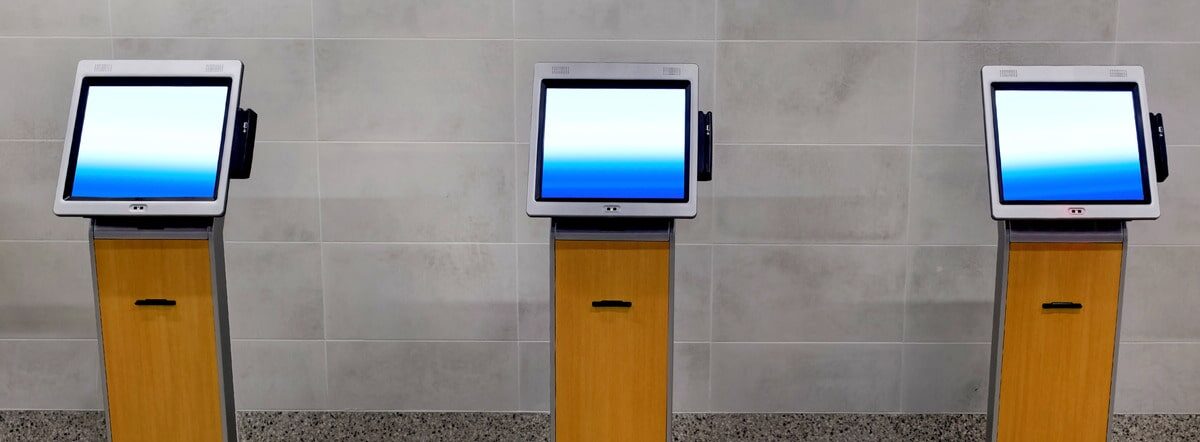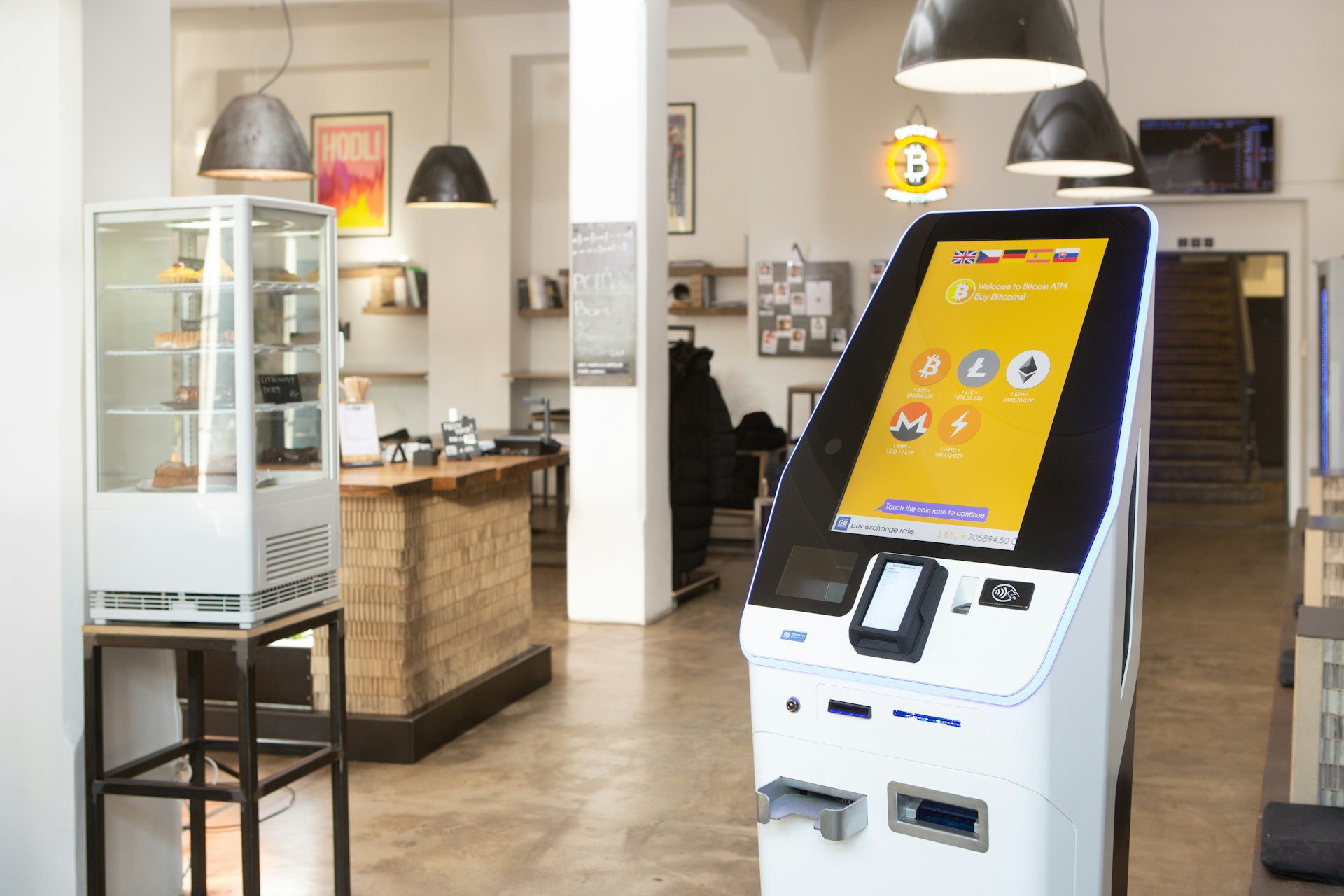Since the pandemic, ne area that has seen significant change for businesses is visitor management and the way they sign in and out visitors. Gone are the days when a receptionist would manually log visitors into a paper book. Today, modern businesses are embracing technology like sign-in kiosks to streamline and enhance their visitor management processes. There are many visitor management kiosk benefits, from improving security to enhancing the overall visitor experience.
Table of Contents
- What is a visitor management kiosk?
- What are the Benefits of a Sign-in kiosk?
- Visitor Management Kiosk Implementation Considerations
- Implementation Checklist
- Visitor Management Kiosk Benefit FAQs
What is a Visitor Management kiosk?
A Visitor Management Kiosk is a self-service digital system – typically a touchscreen device – used to register, track, and manage visitors as they enter a building, facility, or site. It replaces traditional paper logbooks with a faster, more secure, and professional check-in process.
These kiosks are commonly placed in reception areas, lobbies, entrances, or security checkpoints and can be used across industries such as corporate offices, schools, hospitals, manufacturing sites, and construction zones.
Let’s Look At The Kiosk Benefits
There are many benefits to implementing a visitor management kiosk in your business, including:
1. Enhanced Efficiency & Time-Saving
One of the most immediate benefits of sign-in kiosks is the efficiency they bring to the check-in process. Traditional methods, such as paper logs or manual data entry by a receptionist, can be time-consuming and prone to errors. Sign-in kiosks, on the other hand, allow visitors to quickly and easily enter their information through a user-friendly touchscreen interface. This automation significantly reduces waiting times, enabling visitors to complete the sign-in process within seconds.
For businesses, this increased efficiency means that front desk staff can focus on other tasks rather than spending time on repetitive administrative duties. In busy environments where multiple visitors may arrive simultaneously, the ability to handle several check-ins at once without bottlenecks is invaluable.
2. Improved Security & Compliance
Security is a top priority for any business, and sign-in kiosks offer a robust solution for managing who enters the premises. Unlike traditional logbooks, which can be easily overlooked or misused, digital kiosks provide a secure, accurate, and time-stamped record of all visitors. This ensures that only authorised individuals gain access to specific areas of the building.
Sign-in kiosks can also be integrated with other security systems, such as access control, to further enhance safety. For example, a visitor may be required to present identification, which the kiosk can scan and store digitally, or a photo can be taken and printed onto a visitor badge. This makes it easier to identify visitors and ensures that sensitive areas of the business are protected.
Additionally, in the context of data protection laws such as GDPR, sign-in kiosks offer a way to securely manage personal data. Digital records are encrypted and stored in compliance with legal requirements, reducing the risk of data breaches and ensuring that visitor information is handled responsibly.
3. Enhanced Visitor Experience
First impressions matter, and the visitor experience begins the moment they walk through the door. A well-designed sign-in kiosk can contribute to a professional and modern image, giving visitors confidence in the organisation’s use of technology and its commitment to efficiency.
The intuitive design of sign-in kiosks ensures that the check-in process is straightforward, even for those who may not be familiar with the technology. Customisable features, such as branding, welcome messages, and instructions, can make the experience more personalised and welcoming. In environments where privacy is important, sign-in kiosks also provide a discreet way for visitors to check in without needing to share their information aloud or in front of others.
Many sign-in kiosks also offer contactless check-in options, such as QR code scanning. This not only helps to reduce physical contact allowing businesses to utilise unmanned receptions.
4. Data Collection & Analytics
Sign-in kiosks are not just about managing visitors; they are powerful tools for collecting and analysing data. The digital nature of these kiosks allows businesses to easily track visitor trends, such as peak times for arrivals, frequent visitors, and the purpose of visits. This information can be invaluable for improving operations and planning resources effectively.
For example, understanding visitor flow can help businesses optimise staffing levels at reception or plan meetings more efficiently. In industries such as healthcare, education, or large corporate offices, this data can also be used to monitor compliance with safety protocols, such as health screenings or visitor capacity limits.
Moreover, the ability to generate detailed reports from sign-in kiosk data means that businesses can quickly access and review historical visitor records when needed, whether for security audits, legal compliance, or internal analysis.
5. Cost-effective & Scalable
While the initial investment in a sign-in kiosk system may seem significant, the long-term cost savings make it a worthwhile expense. By reducing the need for paper, printing, and manual data entry, businesses can save on operational costs over time. Additionally, the automation of the check-in process means that less staff time is needed to manage visitors, allowing for better allocation of human resources.
Sign-in kiosks are also highly scalable, making them suitable for businesses of all sizes. Whether you are a small office with a single kiosk or a large corporation with multiple locations, these systems can be easily expanded or customised to meet your specific needs.
6. Environmental Benefits
In an age where sustainability is increasingly important, sign-in kiosks offer an eco-friendly alternative to traditional visitor management methods. By eliminating the need for paper sign-in sheets, these kiosks help reduce paper waste, aligning with broader environmental goals.
Digital visitor management also reduces the need for physical storage space for paper records, further contributing to a more sustainable and efficient workplace.
Incorporating sign-in kiosks into your business operations is more than just a technological upgrade; it’s a strategic move that enhances efficiency, security, and the overall visitor experience. As businesses continue to adapt to the demands of the modern world, those that leverage the benefits of sign-in kiosks will be better positioned to create a safe, efficient, and welcoming environment for all their visitors. Whether you’re looking to improve security, streamline processes, or simply present a more professional image, sign-in kiosks offer a versatile and valuable solution.
Visitor Management Kiosk Implementation Considerations
Implementing a visitor management kiosk is a strategic move that can greatly enhance security, streamline operations, and modernise your reception process. However, to ensure success, several important factors need to be considered during planning and deployment.
Understanding Visitor Types & Workflow Needs
Start by defining the types of visitors who will use the system. This may include guests, staff, contractors, or delivery drivers, each of whom may require a different sign-in workflow. For example, contractors might need to complete safety inductions or sign compliance documents, while guests may only need to enter basic details. Understanding these needs helps tailor the kiosk experience accordingly.
Strategic Placement & Accessibility
The location of the kiosk is also critical. It should be installed in a highly visible and easily accessible area, such as the main entrance or reception. Make sure it is positioned to avoid crowding during busy periods and is compliant with accessibility standards, including accommodations for wheelchair users.
Choosing the Right Hardware
When selecting hardware, think about the physical environment. For indoor use, a standard touchscreen kiosk may suffice, but for outdoor settings, weatherproof units with bright screens are essential. You should also decide whether additional peripherals like badge printers, QR code scanners, or cameras are needed to enhance functionality.
Ensuring Connectivity & Power Reliability
Reliable connectivity and power supply are fundamental. The kiosk should have stable internet access – either via Wi-Fi or a wired connection – and a backup power source, such as a UPS, to ensure it remains operational during outages. It’s also beneficial to choose a system that can function offline temporarily, syncing data when connectivity is restored.
Branding & User Experience
Custom branding and user experience matter just as much as functionality. The kiosk should reflect your organisation’s image with your logo, brand colours, and a welcoming message. The interface should be intuitive, with clear instructions and support for multiple languages if necessary, to accommodate a diverse visitor base.
Data Privacy & Compliance
Data protection is another key consideration. Ensure that your visitor management system complies with GDPR and other privacy regulations. This includes secure data encryption, visitor consent processes, customizable data retention policies, and restricted access to sensitive logs.
Integrating with Existing Systems
Integrations with other systems can maximise efficiency. The kiosk should ideally connect with access control systems like electronic door locks or turnstiles, calendar systems for automatic host notifications, and fire safety software for real-time evacuation lists. Integration with HR and contractor management platforms can also streamline record-keeping and site compliance.
Preparing Staff for Success
It’s equally important to prepare your team. Receptionists, security staff, or site managers should be trained on how to monitor check-ins, assist users, and troubleshoot any technical issues. Internal communication is key to making staff aware of the change so they can confidently guide visitors through the new process.
Planning for Multi-Site Scalability
For organisations with multiple sites, scalability becomes vital. A cloud-based system enables centralised management of kiosks across all locations, allowing for a consistent visitor experience while still supporting site-specific customisation.
Monitoring Performance & ROI
After implementation, monitor the system’s performance regularly. Evaluate whether check-in times have improved, safety protocols are being met, and alerts are functioning correctly. Review the data and reports to identify opportunities for further optimisation and to measure the return on investment.
Visitor Management Kiosk Implementation Checklist
Use our checklist below to help you plan the implementation of a visitor management kiosk in your workplace:
☐ Define Objectives
– Identify your goals: security, efficiency, compliance, or visitor experience.
☐ List Visitor Types
– Visitors
– Contractors
– Employees
– Delivery drivers
– Pre-registered guests
☐ Map the Sign-In Workflow
– Determine data to collect per visitor type
– Include safety forms or legal agreements
– Set up optional features: photo capture, badge printing
☐ Select Appropriate Kiosk Hardware
– Indoor or outdoor unit
– Touchscreen durability and size
– Add-ons: printer, camera, barcode scanner
– Accessibility support
☐ Design the User Interface
– Custom branding (logo, colours, welcome screen)
– Clear on-screen instructions
– Multi-language support (if required)
☐ Choose a Strategic Kiosk Location
– High-visibility near entrance/reception
– Easy access for all users
– Avoids crowding and confusion
☐ Check Power and Network Requirements
– Stable power source
– Reliable wired or wireless internet
– Backup power (UPS)
☐ Integrate with Existing Systems
– Access control systems
– Host notifications (SMS/email)
– Evacuation list and fire safety tools
– Contractor management or HR systems
☐ Ensure Data Security & Compliance
– GDPR and data protection compliance
– Secure encryption and consent collection
– Data retention policy configuration
☐ Train Internal Teams
– Front desk, security, and IT staff
– Visitor assistance and issue handling
– Monitoring and reporting tools
☐ Launch and Communicate Internally
– Notify staff and departments
– Test kiosk functionality
– Place guidance signage
☐ Monitor and Optimise Usage
– Review visitor logs and check-in times
– Use reporting tools for insights
– Adjust flows based on visitor feedback
☐ Plan for Multi-Site Expansion
– Centralised admin dashboard
– Consistent branding and workflows
– Site-specific customisation
How InVentry can help
InVentry’s sign-in kiosks are fully customisable and offer many sign-in kiosks Benefits to enhance your visitor management processes. Contact us today to understand how our sign-in kiosk machines can help your company today.
Visitor Management Kiosk Benefit FAQs
How does a visitor management kiosk improve security?
Visitor management kiosks track every individual who enters your premises in real time. Features like ID scanning, badge printing, and photo capture help confirm identities, while integration with access control systems ensures only authorised individuals can enter specific areas.
Can it reduce staffing needs at reception?
Yes. Automating the check-in process reduces the reliance on manual sign-ins and frees up reception staff for higher-value tasks like assisting visitors or managing internal communications. In some cases, it can eliminate the need for full-time front desk coverage.
Is it cost-effective for small to medium businesses?
Absolutely. While the upfront cost varies, the long-term ROI comes from time savings, reduced administrative errors, and improved compliance. Many systems are scalable, making them affordable for businesses of all sizes.
What kinds of reporting and analytics are available?
Most systems include built-in analytics dashboards that provide real-time insights on visitor volume, peak check-in times, host performance, and contractor activity. These reports help businesses optimise staffing, improve safety, and audit compliance more efficiently.



